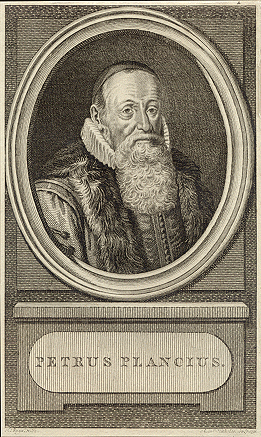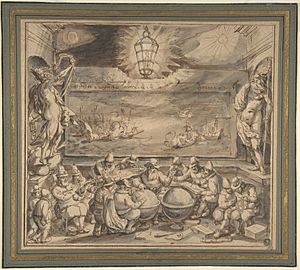Petrus Plancius facts for kids
Petrus Plancius (1552 – 15 May 1622) was a Dutch-Flemish astronomer, mapmaker, and clergyman. He was born as Pieter Platevoet in Dranouter, which is now in Heuvelland, West Flanders. He studied theology (the study of religion) in Germany and England. When he was 24, he became a minister in the Dutch Reformed Church.
Plancius had to leave Brussels and move to Amsterdam in 1585. He faced problems because of his religion after the city was taken over by the Spanish. In Amsterdam, he became very interested in navigation (how to steer ships) and cartography (making maps). He got to see new maps from Portugal. Soon, he was known as an expert on safe sea routes to India and the nearby "spice islands." These routes were important for trade and setting up colonies, like the Dutch East Indies. This area was later named after the Dutch East India Company, which started in 1602. Plancius also thought the Arctic Ocean could have a new sea route. He strongly believed in a Northeast Passage until a trip by Willem Barentsz in 1597 showed it was not possible.
Mapping the World: Cartography
In 1592, Plancius published his most famous world map. It was called "Nova et exacta Terrarum Orbis Tabula geographica ac hydrographica." Only one copy of this map is known to exist today. It is kept in a college in Valencia, Spain. Plancius also wrote books and guides for sailors. He even created a new way to figure out longitude, which helps ships know their exact east-west position. He also supported using the Mercator projection for maps, which is a way to show the round Earth on a flat map.
Plancius was one of the people who started the Dutch East India Company. He drew more than 100 maps for this company. He also knew Henry Hudson, a famous explorer who explored parts of the New World. Plancius also made a map of China and Southeast Asia for a popular book called Itinerario (1596), written by Jan Huygen van Linschoten.
Mapping the Stars: Uranography
In 1589, Plancius worked with Jacob van Langren, a mapmaker in Amsterdam. They made a celestial globe, which is like a map of the stars. It was 32.5 centimeters (about 13 inches) wide. They used the little information they had about stars in the southern sky. On this globe, they showed Crux (the Southern Cross), Triangulum Australe (the Southern Triangle), and the Magellanic Clouds.
In 1595, Plancius taught Pieter Dirkszoon Keyser how to observe stars. Keyser was the main pilot on a ship called the Hollandia. Plancius wanted Keyser to find new stars in the southern sky. Keyser died in Java the next year, but he had already made a list of 135 stars. He probably got help from his friend Frederick de Houtman. This list was given to Plancius when the ships returned.
These stars became 12 new constellations (groups of stars). Plancius designed them in late 1597 or early 1598. He worked with another mapmaker, Jodocus Hondius the Elder, to make a 35-centimeter (about 14-inch) celestial globe. The 12 new constellations were mostly named after animals. These included Apis the Bee (now called Musca), Apus the Bird of Paradise, Chamaeleon, Dorado the Goldfish, Grus the Crane, Hydrus the Small Water Snake, Indus the Indian, Pavo the Peacock, Phoenix, Triangulum Australe the Southern Triangle, Tucana the Toucan, and Volans the Flying Fish. The Southern Triangle and Southern Cross were known before, but Plancius's globe was the first to show their locations accurately. He also included Achernar as a bright star in the constellation Eridanus.
These constellations, along with Columba (the Dove) which Plancius drew on his 1592 world map, were later added to a famous star atlas. This atlas, called Uranometria, was published by Johann Bayer in 1603.
In 1612 or 1613, Plancius added eight more constellations to a celestial globe. This globe was published in Amsterdam by Pieter van der Keere. These new constellations included Apes the Bee, Camelopardalis the Giraffe, Cancer Minor the Small Crab, Euphrates Fluvius et Tigris Fluvius (the Rivers Euphrates and Tigris), Gallus the Cock, Jordanis Fluvius (the River Jordan), Monoceros the Unicorn, and Sagitta Australis the Southern Arrow. Today, only Camelopardalis and Monoceros are still recognized by the IAU.
A minor planet (a small space rock) called 10648 Plancius is named after him. This honors his important work in mapping both the Earth and the stars.
Maps
-
Ceilan, 1595
-
Nova Francia .. Terra Nova 1592
-
Insulae Moluccae 1592
See also
 In Spanish: Petrus Plancius para niños
In Spanish: Petrus Plancius para niños
- First Dutch Expedition to Indonesia








